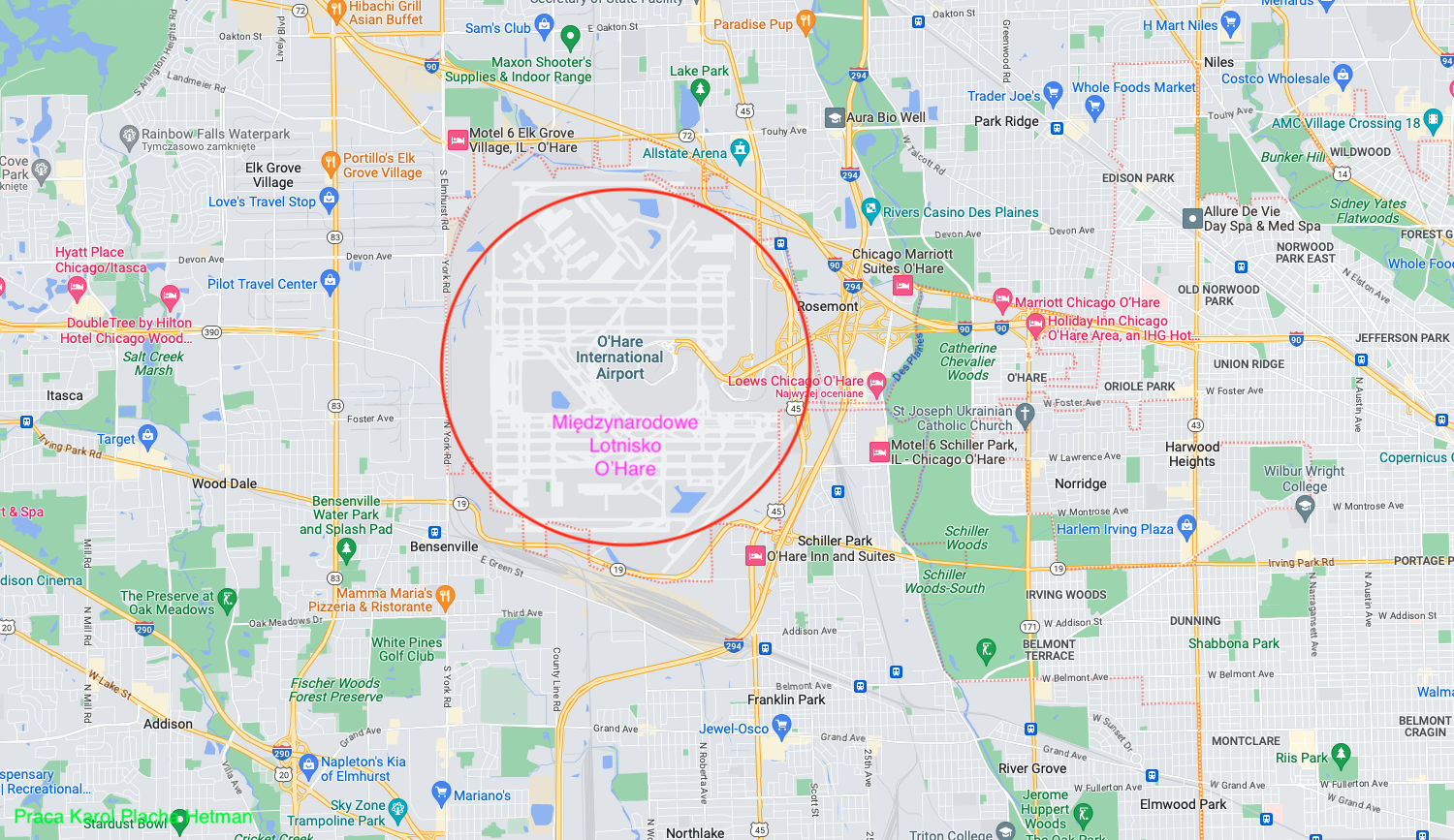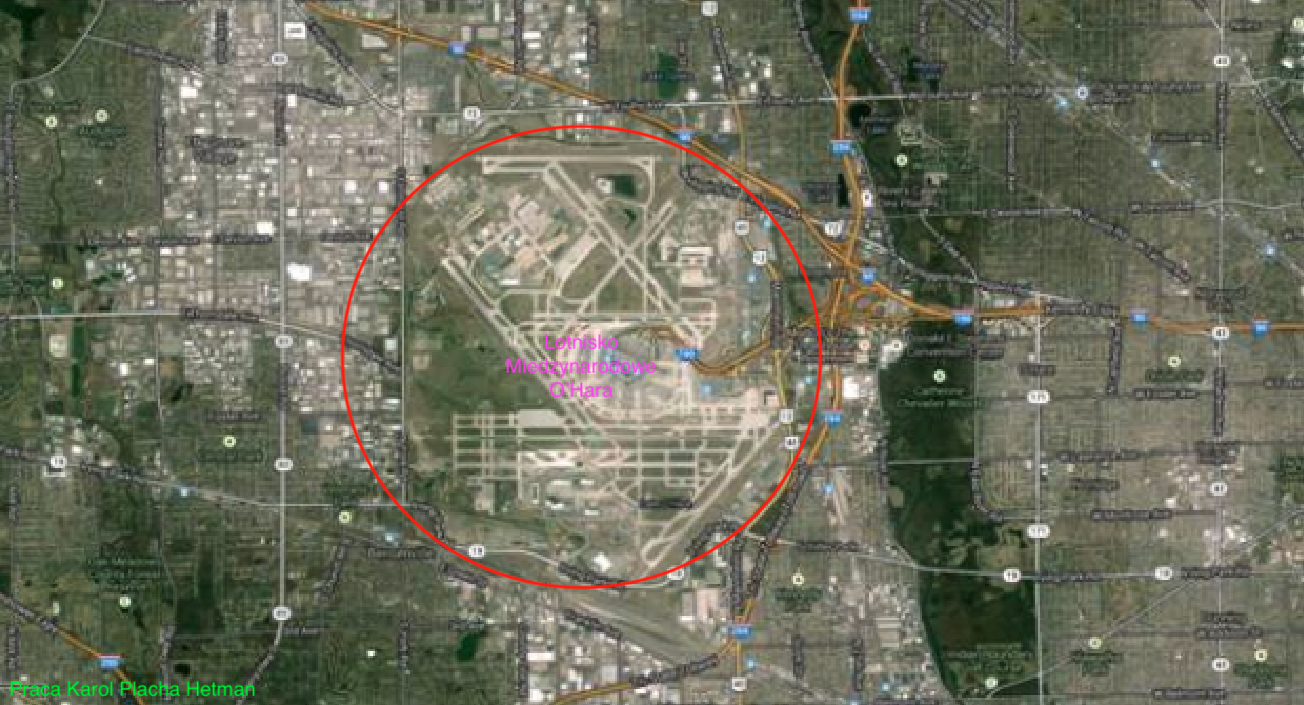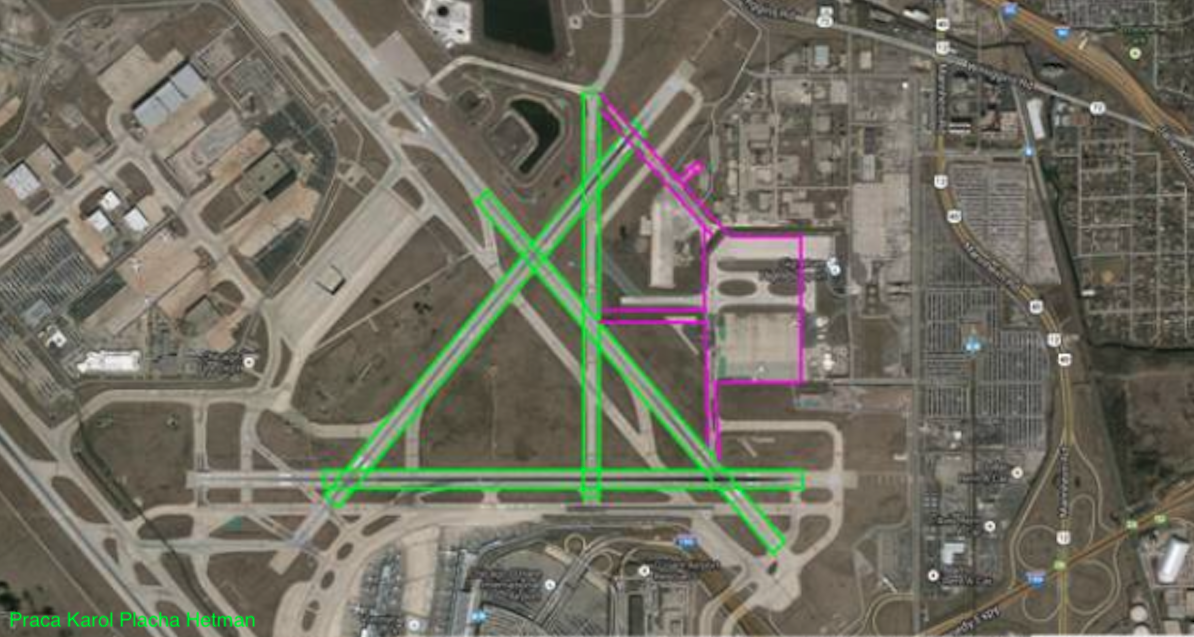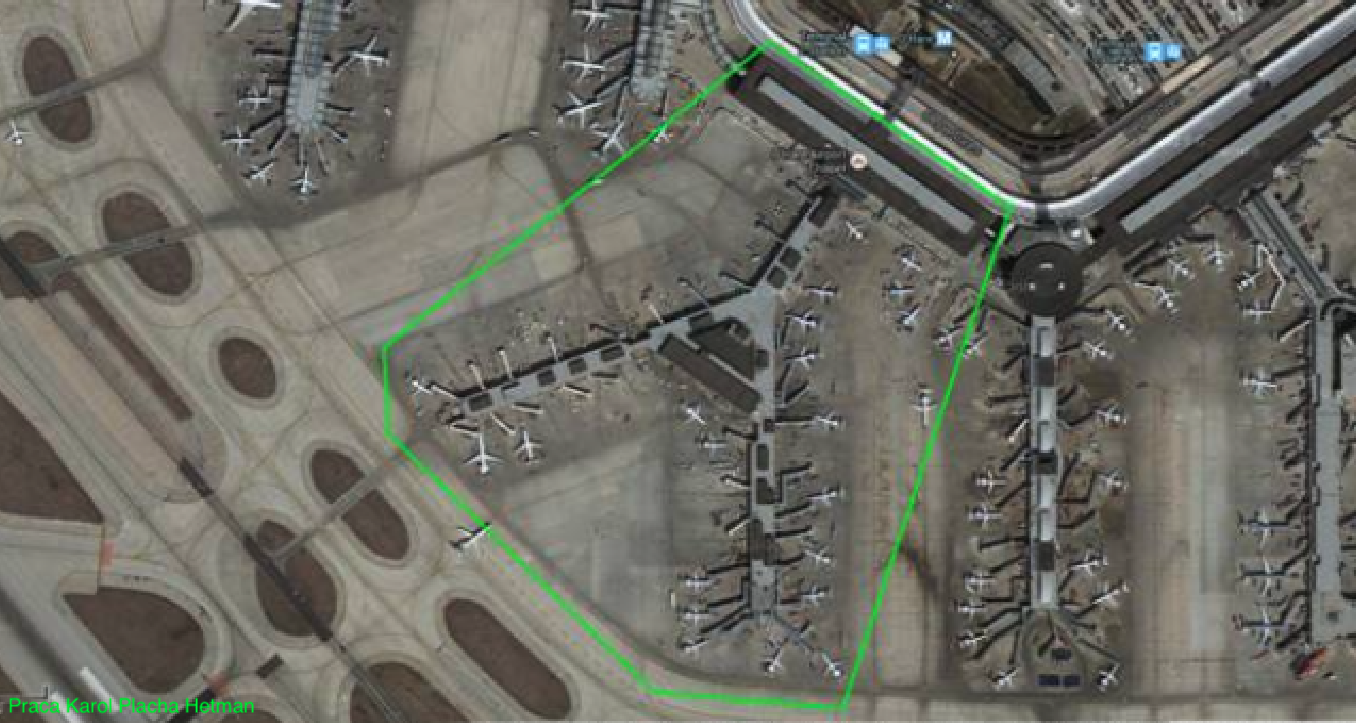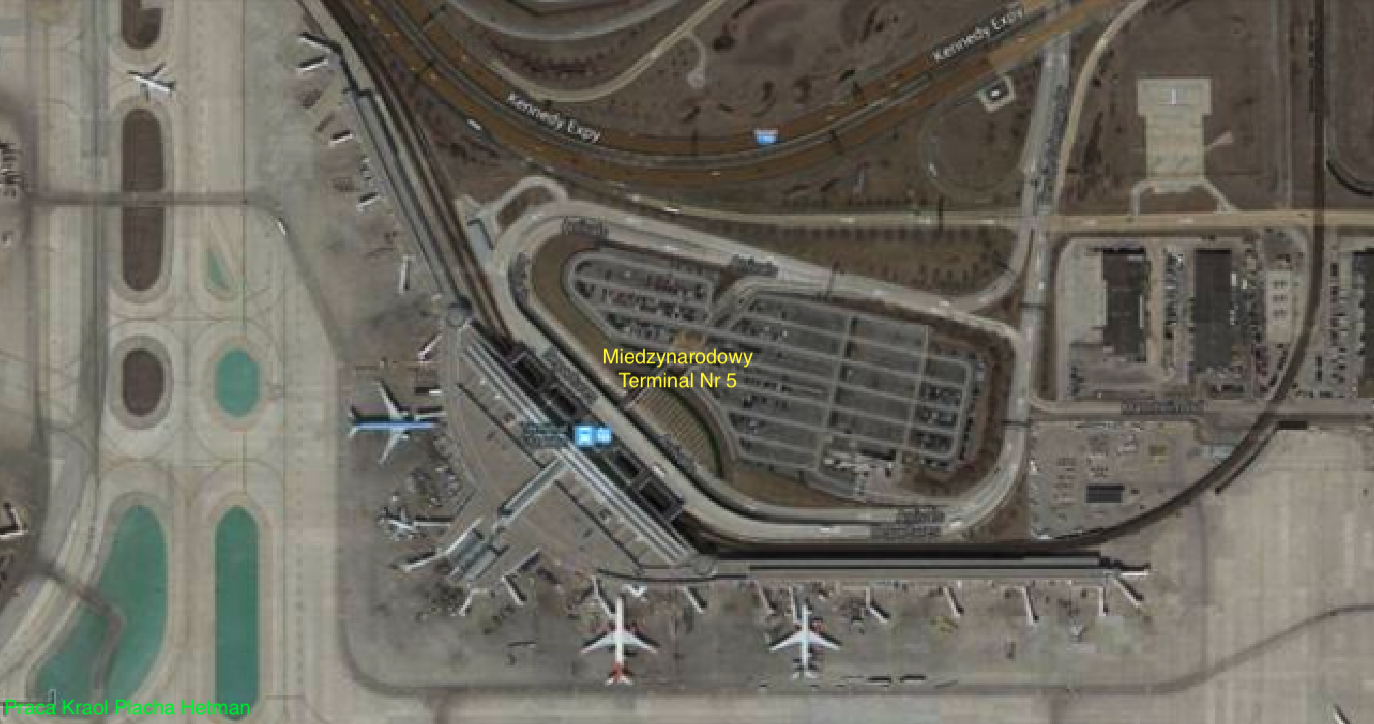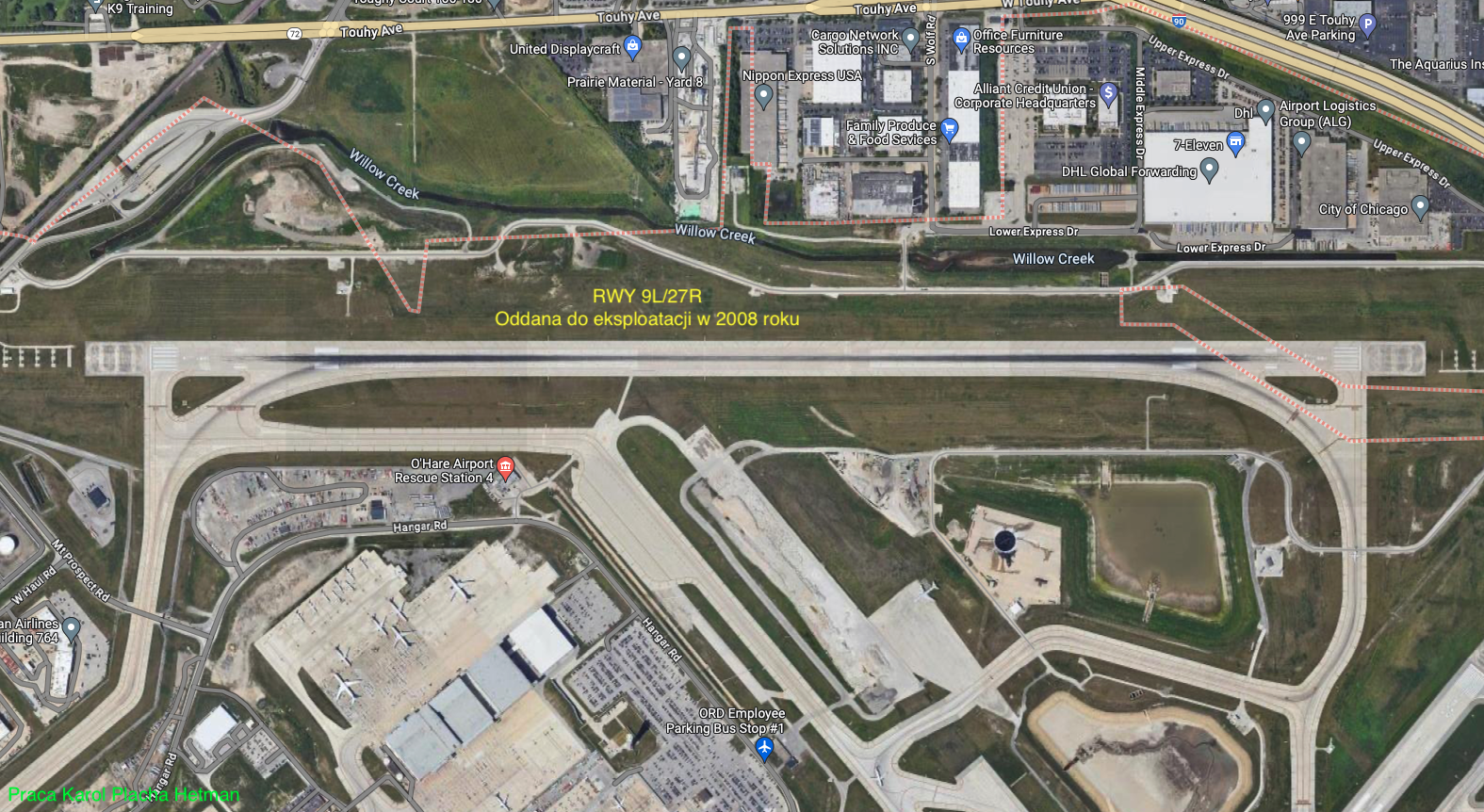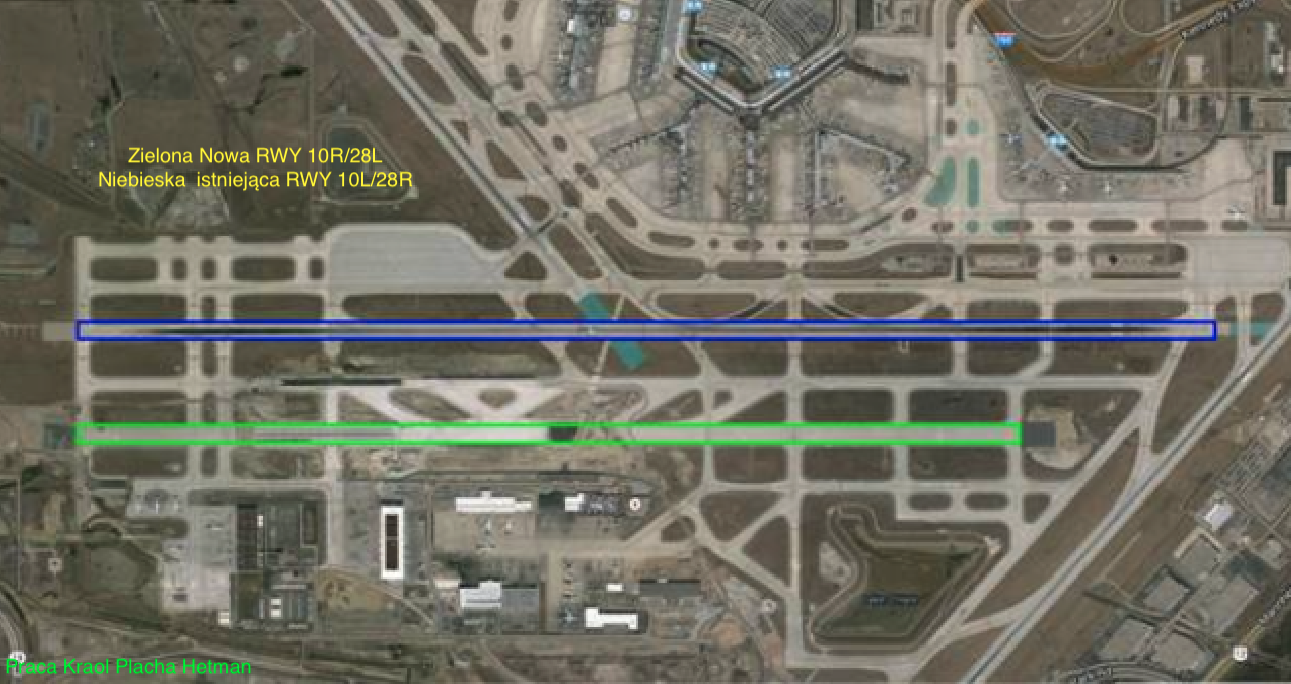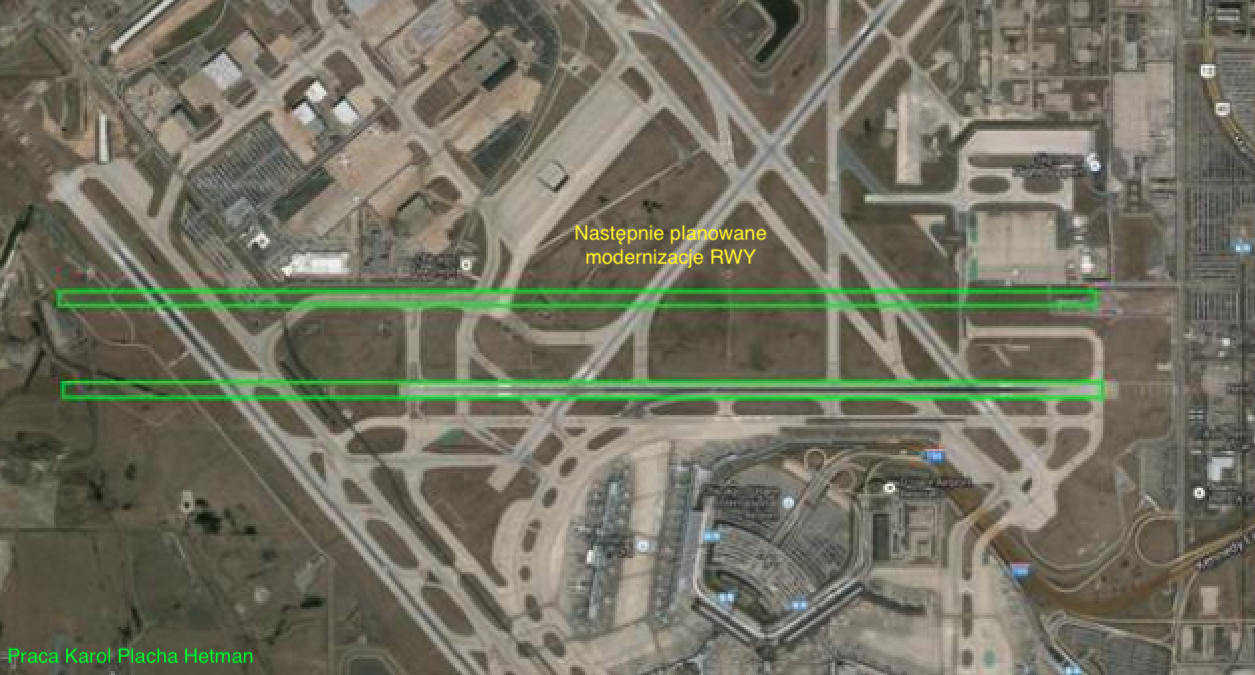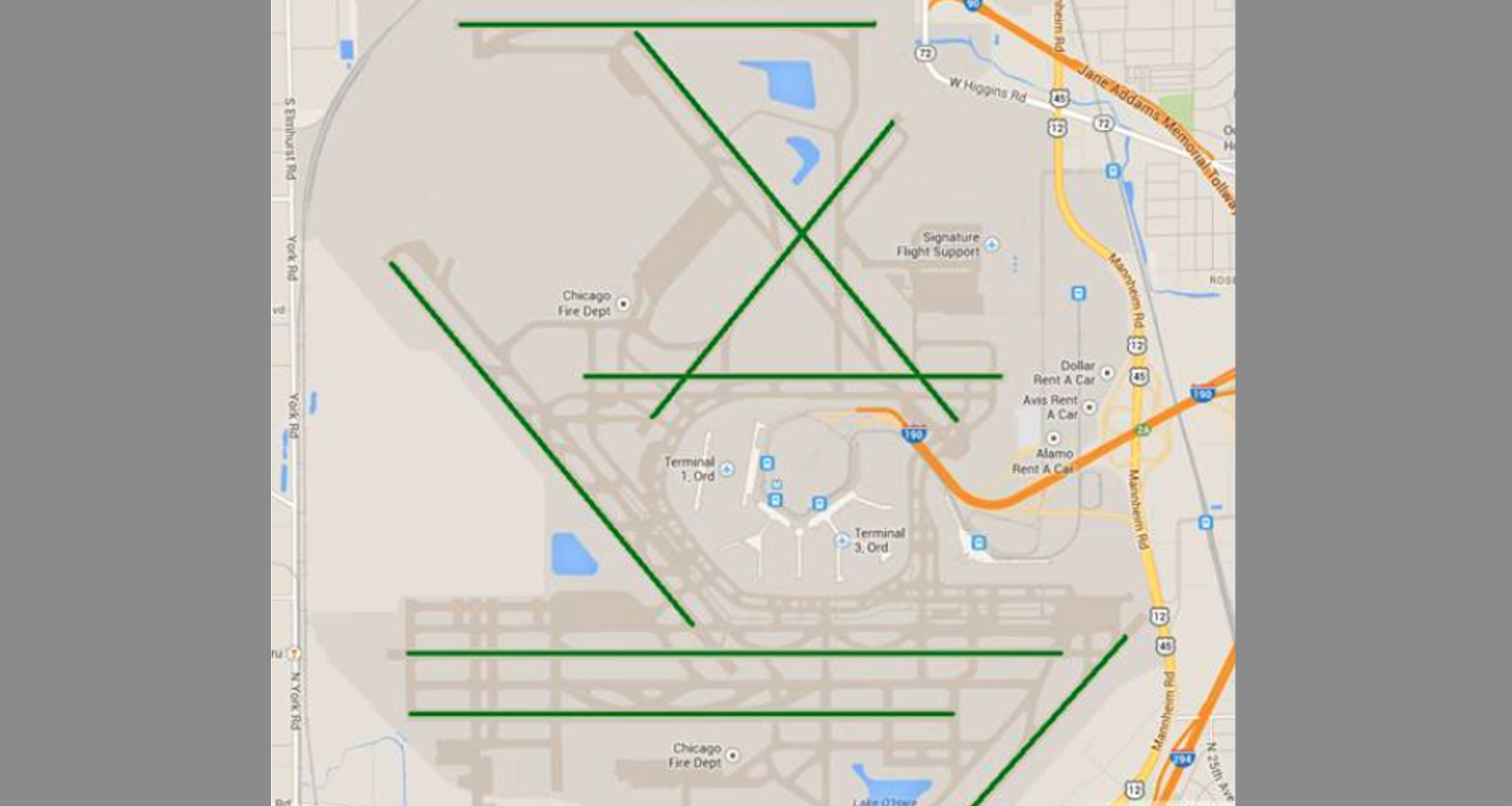Chicago 2013-11-12
Lotnisko Chicago – O’Hare.
Geographic coordinates: 41.976 N 87.908 W.
Chicago.
We were prompted to write about the Chicago-O’Hare airport by the Warsaw-Chicago flight route, the most popular among Poles. All thanks to Poles and Americans of Polish origin.
The USA is the country with the largest Polish community in the world. The main places of residence of the Polish diaspora in the USA are the cities: Chicago, Denver, Detroit, Los Angeles, New York and Seattle. It is estimated that nearly 10 million people of Polish origin live in the United States, and approximately 600,000 of them use Polish on a daily basis. Chicago is the second city in the world, after Warsaw, in terms of Polish population. The first Poles arrived in North America twelve years before the so-called "Pilgrims" who reached Massachusetts in 1620. At the end of the 18th century, during the partitions of the Polish-Lithuanian Commonwealth, some Polish patriots, including Kazimierz Pułaski and Tadeusz Kościuszko, went to America to help fight for its independence. Poles began to emigrate in larger numbers to the United States in the 19th century, after the national uprisings. They mainly settled in New England and Illinois. Subsequent large waves of emigration from Poland to the USA were born for economic reasons (from the second half of the 19th century until 1939, and then after 1980. For political reasons (after World War II) and for economic and political reasons (80s of the 20th century). According to official data, over 2.2 million Polish immigrants came to the United States between 1820 and 1914. The official census in 1940 listed 993,479 Americans born in Poland and 2,416,320 who spoke Polish as children. In 1958, the Polish American Congress estimated the number of Americans of Polish origin at 6 million 372 thousand. The largest share of them was among the inhabitants of Connecticut (11.1%), Illinois (9.6%) and New York (8.3%).
The largest concentration of Poles and people of Polish origin outside Poland (over 1.3 million people of Polish origin, including about 250,000 who speak Polish on a daily basis) is in Chicago. There are three mainly Polish neighborhoods in Chicago, the most famous of which is Polish Village. Until the 1980s, a large part of Poles in Chicago lived in the Polish Village district, commonly known as the parish and church of St. Jacek – called Jackowo. In the following years, under pressure from Latino immigrants moving northwest, Poles began to move north and west along Belmont Avenue, Irving Park Road, Milwaukee Avenue and Central Avenue; an increasing number of them live in closer and further suburbs. Chicago is a great center of organized Polish diaspora. The seat of the central authorities of the Polish American Congress (PAC), the Polish National Alliance (PNA), the Polish Roman-Catholic Union (PRCU), the Polish Women’s Alliance of America – PWAA), Polish Highlanders Alliance of North America – PHAA) and many other organizations. The oldest Polish monument is the church of St. Stanisław Kostka, built around 1870, and the Polish Roman Catholic Union houses the rich collections of the Polish Museum in America. To this day, Chicago is widely recognized as the great center of the Polish American community. In the Almanac of American Politics from 2004, it was written that "Even today, in the Archer Heights neighborhood, you can barely walk one block without hearing Polish" (Archer Heights is a district located in the southwest of the city along Archer Avenue, inhabited mostly by immigrants from Podhale; the Podhale House is located on Archer Avenue. Poles are the largest ethnic group among property owners in Chicago.
O’Hare Airport.
Chicago (Illinois) is the most famous city in the USA for Poles, due to the largest Polish population. Chicago has two international airports; O’Hare and Midway. O’Hare (IATA-ORD code, ICAO-KORD code). It is situated 27 km northwest of the city center, within its administrative boundaries. It is named after the American military pilot, Edward "Butch" O’Hare.
From the very beginning, the airport was one of the most important air navigation airports in the USA and in the world. You could say that no one likes this airport, but everyone wants to fly here. This is due to several reasons, of which history comes first. Well, this is where one of the world’s largest airline companies, United Airlines, established its headquarters. As the name suggests, it was created from the merger of several smaller companies. Already in the 1930s, the city maintained permanent mail and passenger connections with Detroit, Buffalo and New York.
On May 8, 1926, Chicago’s Municipal Airport, now known as Midway, was opened. This airport quickly turned out to be too small. At a cost of approximately $10,000,000, it was enlarged and expanded over 10 years. But the possibilities of adding additional areas have been exhausted.
After the attack on Pearl Harbor, the thinking of American planners changed. It became necessary to build new arms plants in the interior of the country. Within a few days, the location for new factories and airports was selected. In Chicago, areas were selected near the small town of Orchard Place, founded in 1840, where in 1854 a stop on the Illinois-Wisconsin railway was built, called Depot Place Orchard. This site was one of many possible sites identified during searches in 1930 and due to its proximity to the city, the availability of a highly skilled labor force and easy access to major means of transport, especially railways. It was here that it was decided to build an aircraft factory and an airport. The Douglas company decided to build four-engine C-54 Skymaster transport planes here.
In June 1942, the plan was approved and 1,790 (other data: 1,300) acres of land were purchased for the construction of a factory and an airport. The administration allocated $20,000,000 for this purpose, including the construction of aircraft. Despite local protests, on June 18, 1942, local judge William J. Campbell signed the contract for this order and the purchase of the land began. In July 1942, extensive work was already underway. The first investments were the installation of a power line, central heating and land improvement. The first building began to be constructed on June 30, 1942, and the main production hall on August 24, 1942. In November 1942, the first stage of the factory construction was handed over to the Douglas company for work. Due to the shortage of steel, the main building material was wood. This was not a problem because the factory was planned to be closed down after the war. The main manufacturing facility was 2 million square feet, built entirely of wood, and was recognized as the largest wood factory in the world. Uncertainty about the quality of the wood intended for construction motivated engineers to use a reinforced structure.
The problem of the take-off field was also taken seriously. They were designed in accordance with the latest trends. Four RWY runways were built there. The main runway is located in the north-west-southeast direction. This was dictated by the location of Municipal Airport (later Midway) in instrument flight conditions. Additionally, Municipal Airport was considered the traffic model of the time, for safety reasons and operation under instrument flight conditions. The surface was made of thicker than usual concrete, because the steel reinforcement was significantly limited due to the mentioned steel shortages. Each RWY is 5,500 feet long, 150 feet wide and 15 inches thick. Concrete was laid in layers (7-10 layers). The last RWY was completed on August 15, 1943, but take-offs from the airport were carried out from the spring of 1943. The total paved area is 1,300,000 square feet.
Photo description: The layout of the airport in 1943. Green – RWY, Purple – parking areas and taxiways.
The four RWYs had the following directions; 0/18, 4/22, 9/27, 14/32. The most important one was the one in the direction 14/32, because it is the RWY straight to the Municipal Airport (Midway) and did not cause any navigation problems. The least frequently used was RWY in the 0/18 direction and after World War II it was used as a taxiway. This arrangement of the flight field was standard at that time. It allowed for a safe approach to landing from all sides in a relatively small area. However, this arrangement causes all RWYs to cross each other and prevents two machines from landing at the same time.
The factory was called Assembly Plant Chicago. On July 30, 1943, the first C-54 Skymaster transport plane took off. Its uninterrupted production lasted until October 1945. 655 aircraft were built. On July 18, 1944, the administration building burned down. Only thanks to the large distances between individual buildings, the fire did not spread to the assembly hall. The building was quickly rebuilt. At the airport, the army carried out tests on captured Germanic, Italian and Japanese planes.
After the end of World War II, the area returned to the management of the city of Chicago. At the end of 1945, a committee appointed by the mayor of Chicago decided that Orchard Field would be the new airport for Chicago. The reason was the inability to expand Midway Airport. In 1949, the Chicago City Council changed the name of Orchard Field to Chicago-O’Hare International Airport, in honor of naval aviator Lieutenant Commander Edward H. Butch O’Hare, who was killed in World War II. However, it took a very long time to adapt the airport to commercial service. The main reason was the concerns of local communities about a significant increase in noise emitted by new turbojet aircraft.
O’Hare Airport officially opened to commercial air traffic in 1955, and in its first year it served 176,902 passengers. In the 1950s, RWY 14/32 and RWY 9/27 were renovated and extended. A little later, the same was done with RWY 4/22. In 1958, a new RWY R14/L32 (No. 4) was put into use, much further away from the existing one and running in front of Terminal No. 1. This road received a parallel taxiway and as many as six rapid exits, spaced every 1,000 feet. It was noticed that fast descents enable an increase in the number of flight operations. It is also worth mentioning Terminal No. 1. The first terminal was built on the southern side of RWY 9/27. It was a relatively simple station building with a pier perpendicular to it. Currently (2013) non-existent. The first real terminal No. 1 was added to the station building. It was built on a Y-shaped plan and its size corresponded to the later built terminals No. 2 and 3, already planned at that time. Later, Terminal No. 1 was rebuilt and now (2013) it looks completely different. The main taxiways have been designed around the planned terminals in an incomplete circle. They are doubled and exist to the present. They allow for safe circular movement of aircraft.
In 1959, it was decided to expand the airport area to include additional areas. On April 1, 1959, the expansion of another 7,200 acres of land was inaugurated. Mainly south of the existing ascent field. The construction of another terminal, hangars, parking lots, post office and other buildings (catering, car rental) was started on the new area. In 1962, the modern terminal No. 2 was put into use, the first in the world with boarding ramps for passengers. It consists of a large station building and a Y-shaped pier. In 1962, it was decided to move all commercial traffic from Midway Airport (it was planned to close it, but this did not happen) to O’Hare Airport. As a result, in 1962, O’Hare Airport served nearly 10,000,000 passengers. Then the airport was named the busiest airport in the world. On March 23, 1963, O’Hare Airport was officially visited and dedicated by President John F. Kennedy.
In the following years, Terminal No. 3 was built. Its appearance was very similar to Terminal No. 2. In 1978, the US deregulated the federal commercial aviation law signed by President Jimmy Carter. As a result, air traffic increased even more. Another expansion took place. Terminal No. 1 was rebuilt, and another pier was built between Terminal No. 2 and 3. Then the port adopted a layout similar to the current one. At the beginning of the 1970s, another runway was built, RWY 10/28, the southernmost one (No. 5), which then intersected with RWY 14R/32L. Finally, in the 80s, another area was acquired, where the sixth RWY 4R/22L was built. It was the first runway that, by design, does not intersect with others. This road is parallel to the old runway RWY 4/22, now renumbered RWY 4L/22R, and which are significantly separated from each other.
We must know that O’Hara airport, even though it is called an international airport, is primarily a domestic airport. International flights are marginal. Nevertheless, traffic continued to grow. Therefore, it was decided to build another Terminal, marked No. 5. Number 4 was left for another Terminal intended for domestic traffic, which has not yet been built (in 2013). Terminal No. 5 was built east of the existing terminals and does not connect to them. The terminal consists of a station building and two piers. Terminal No. 5 has 21 gates in one pier. It accepts all arrivals from abroad, except for flights cleared under remote US customs and border clearance, the so-called border preclearance – currently used mainly in Canada.
In 1984, a Chicago Transit Authority (CTA) rail line, called the "Blue Line", was connected to the airport terminals. This is complemented by an automatic railway line, opened many years later, running for approximately 3 km and connecting; parking lot, terminal No. 5, terminal No. 3, terminal No. 2 and terminal No. 1.
In 1990, O’Hare Airport served over 60 million passengers. In 1997, O’Hare Airport served over 70 million passengers. By 2005, it was the world’s first airport, serving 76.5 million passengers. In 2005, the FAA imposed restrictions on the airport to reduce delays in arrivals and departures. In 2012, 42 passenger airlines and 27 cargo operators regularly used O’Hare Airport.
Interestingly, the search for a site for a new airport for Chicago has always been unsuccessful. The good areas were far from the city. Nobody wanted to make a long trip to get on a plane. However, closer areas would require the displacement of thousands of people or the liquidation of many workplaces, and no one agreed to this. Since the construction of a third airport for Chicago turned out to be unrealistic, in 2008, it was decided to change the runway system again. It was carried out in stages. The aim was to increase safety and completely eliminate delays in air connections. First, another RWY 9L/27R with a length of 2,460 m was built. It is located in the northernmost part of the airport and was put into operation on November 20, 2008, at a cost of $450 million.
Since 2010, construction of another new RWY 10R/28L with a length of approximately 3,500 m has been underway, close to the existing longest RWY 10L/28R. At the same time, RWY 14R/32L was shortened so that the roads did not cross.
Further modernizations of RWY in the central part of the airport are planned.
It is also planned to build another smaller runway on the southern edge of the airport, located in the east-west direction. The modernization of the RWY system will culminate in the liquidation of both runways in the direction 14/32, which will completely eliminate the intersection of the RWY. We’ll see if this happens. Ultimately, there are to be six RWYs in the east-west direction and two in the north-east – south-west direction. This arrangement will allow the construction of a new terminal in the western part of the airport with access from the west.
In 2013, O’Hare Airport had the following RWYs:
RWY 14L/32R – dimensions 10,000 ft x 150 ft – built in 1943, to be decommissioned in the future. RWY 14R/32 – dimensions 9,690 ft x 200 ft – built in 1958, to be decommissioned in the future. RWY 9R/27L – dimensions 7,967 ft x 150 ft – built in 1943. RWY 9L/27R – dimensions 7,500 ft x 150 ft – built in 2008. RWY 4L/22R – dimensions 7,500 ft x 150 ft – built in 1943. RWY 4R/22L – dimensions 8,075 ft x 150 ft – built in the 1990s. RWY 10L/28R – dimensions 13,000 ft x 150 ft – built in 1970-1975. RWY 10R/28L – dimensions 10,000 ft x 200 ft – built in 2013.
Written by Karol Placha Hetman

